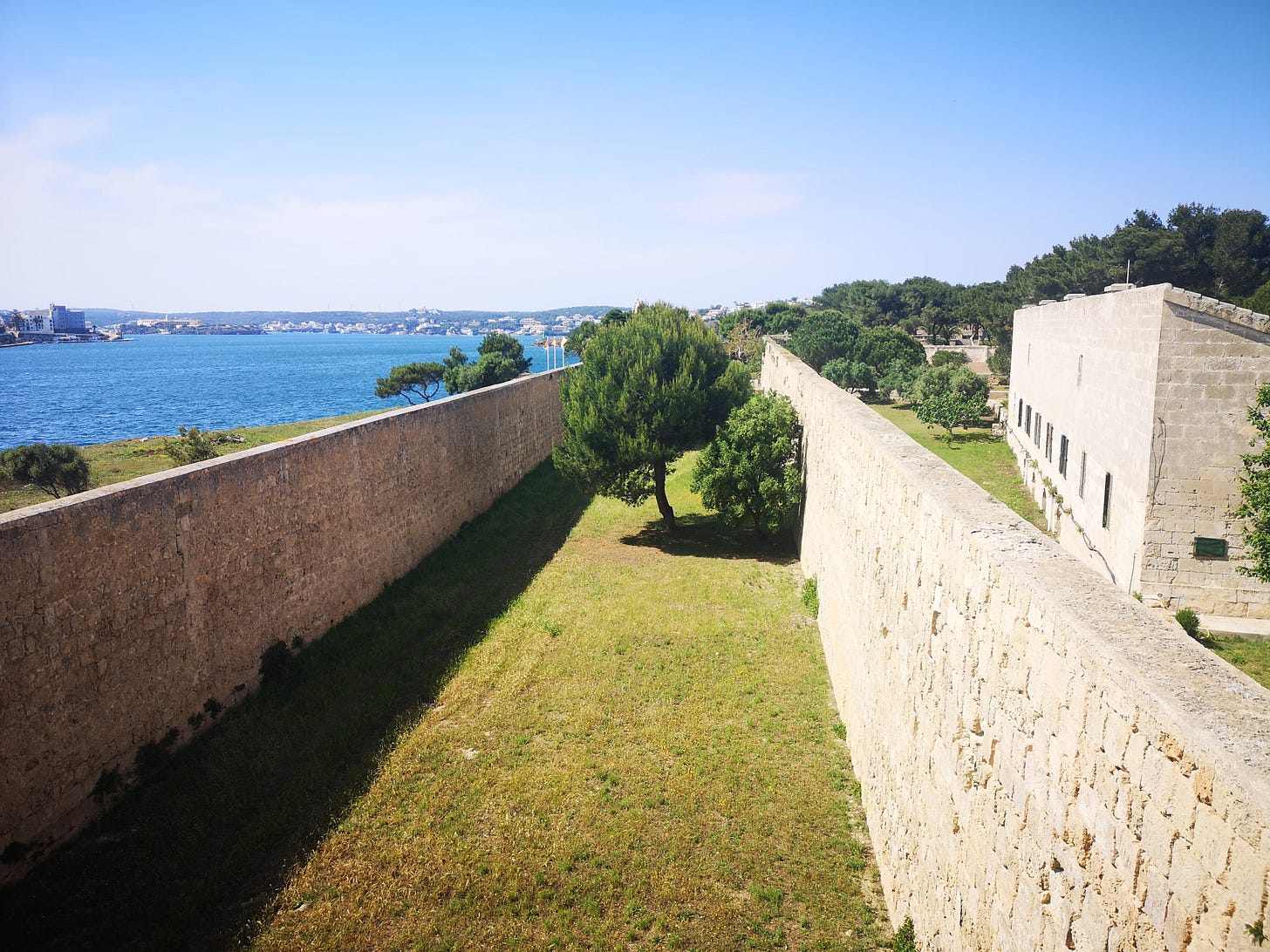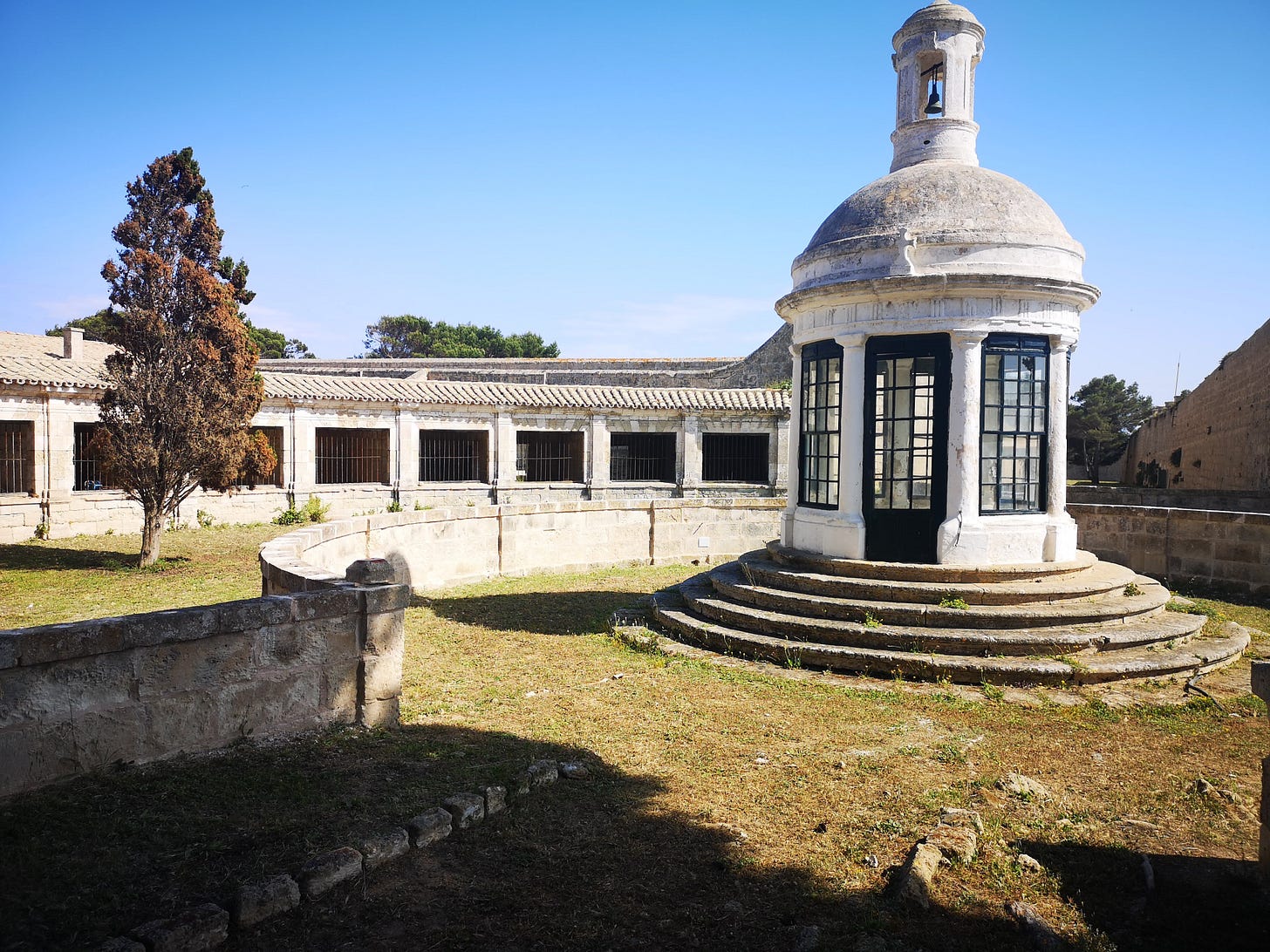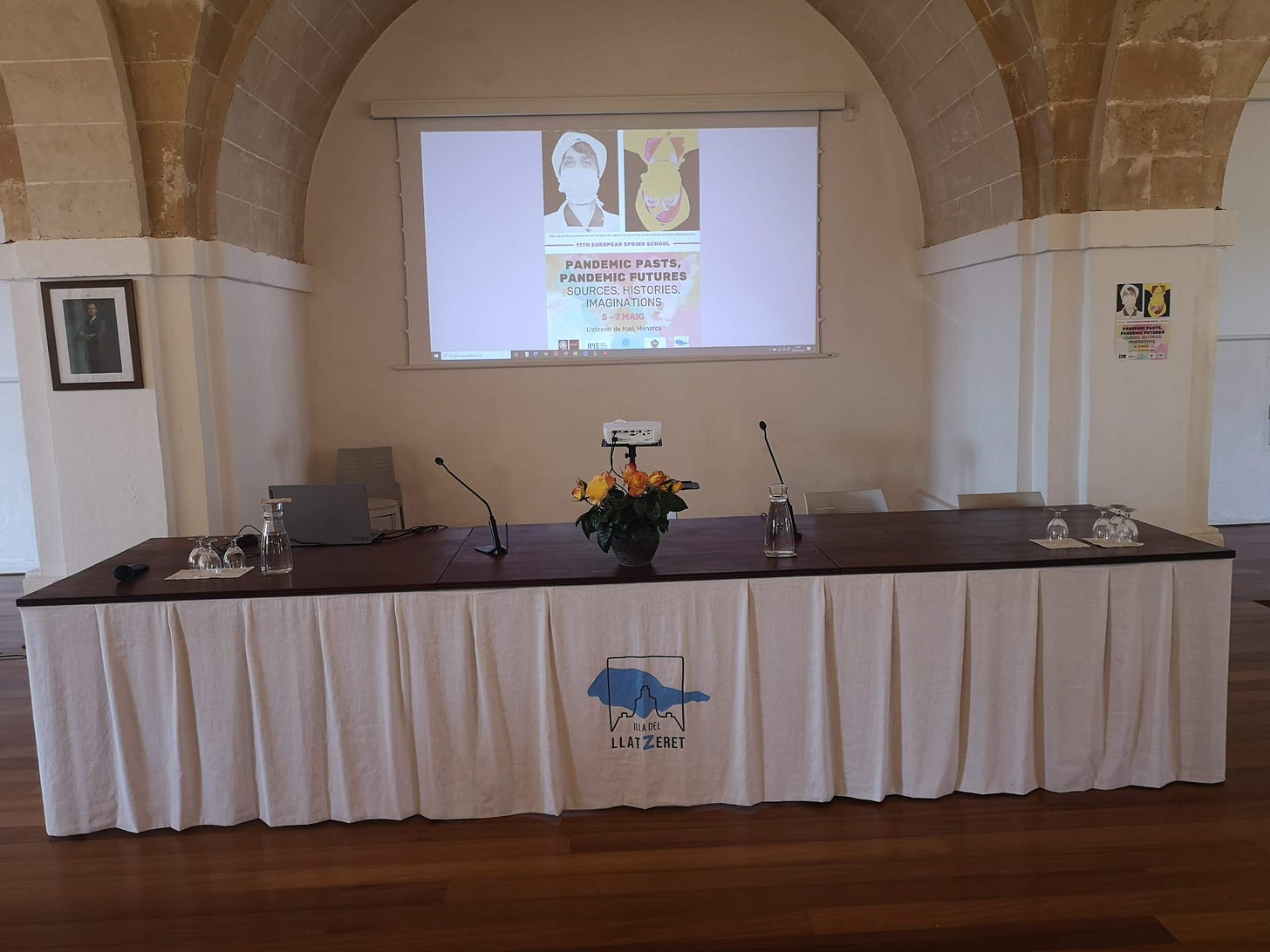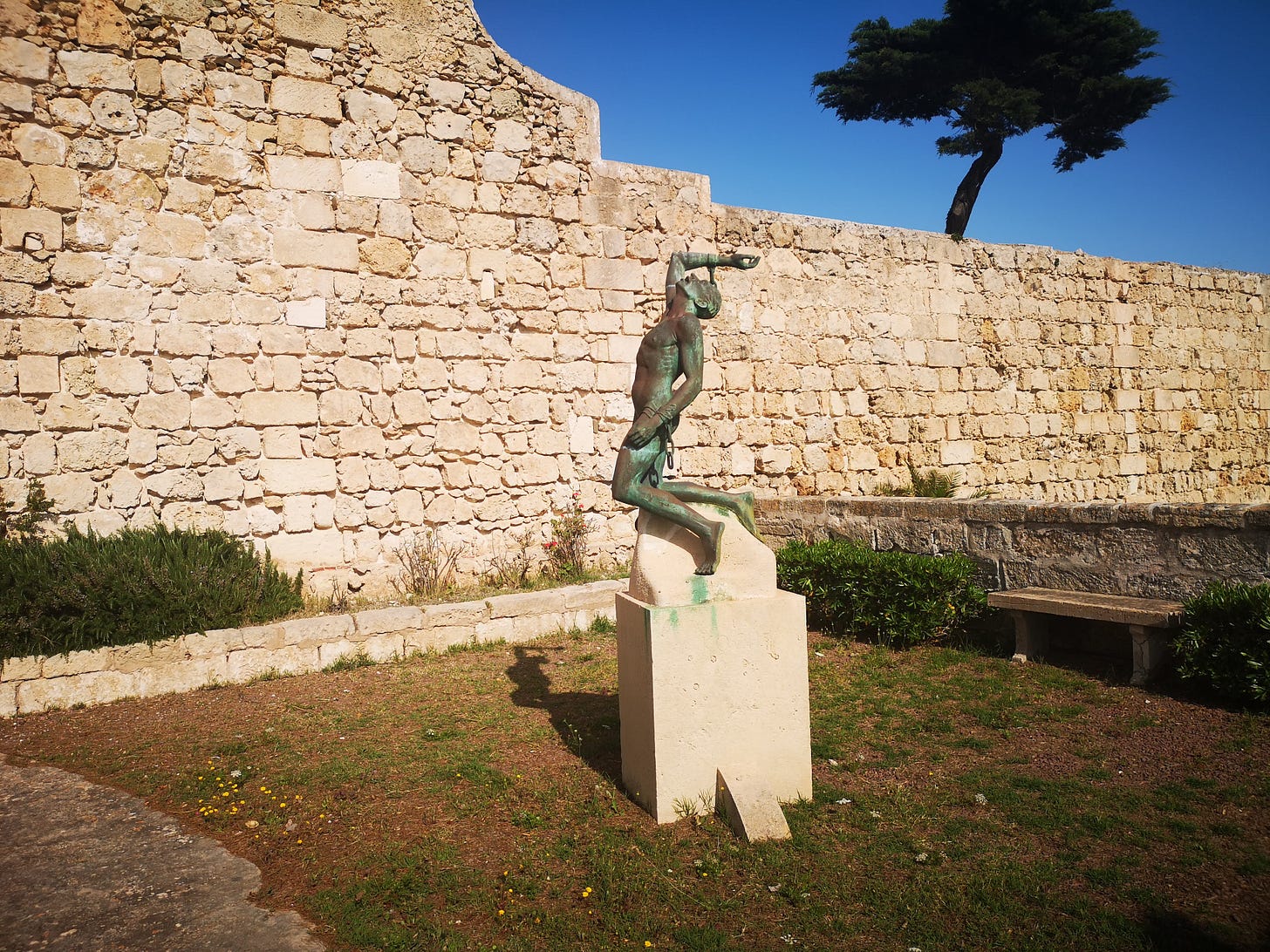Airs, places, pandemic spaces
Where better to contemplate the experience of lockdowns and quarantines than a 19th century Menorcan lazaretto?
From the Llatzeret de Maó you get a magnificent view of Menorca’s capital, Mahón, and its deep-water harbour where in times gone by vessels arriving from the distant outposts of the Bourbon empire were inspected for disease before being permitted to sail on to Marseille and other Mediterranean ports.
Between 1817 and 1917, when the lazaretto was decommissioned, some 40,000 souls passed through its imposing Lions Gate, named for the two prancing lions that adorn its portico. Crew members “suspected” of infection or who had “touched” an infected plague port were typically detained for between twenty to thirty days. Officers were lodged in the lazaretto’s “French Quarters”, whose rooms came with maid service, laundry facilities and, for “first-class”paying guests, the Bourbon-equivalent of a mini-bar (Champagne: 6 pesetas a bottle; Jamaican rum 4 pesetas).
Those infected with plague, cholera or yellow fever were not so lucky, however. These unfortunates were carted or carried (depending on their condition) directly onto ramps leading from the dock to a separate area of the compound where they would spend forty days behind a high wall contemplating the sky and scudding clouds.
Presumably, the food here was not of the same standard as in the French Quarters, nor could detainees count on their beds being turned-down or alcoholic beverages. Nonetheless, they enjoyed access to the facility’s medical service and it is testimony to the lazaretto’s care for its detainees than in a century of use just 396 died, one of them in a fist-fight.
For these and other insights into Mahón’s lazaretto I am indebted to Luis Ameller, a local Menorcan tour guide, and the Catalan History of Science and Technology Society, whose inspired idea it was to hold their 11th European Spring School for doctoral students in one of the lazaretto’s halls. Thanks to the support of the Menorcan Institute of Studies, who co-sponsored the workshop, for three days I and other medical historians were able to wander the lazaretto’s tranquil grounds, reflecting on our experiences of lockdowns, quarantines and the history of pandemics.
As we look back on the last two years of living Covidly, it’s tempting to think that our experience is unique, that never have people been locked down or quarantined – or debated the pros and cons of ventilation and the best type of disinfectant.
But as the visit to Mahón’s lazaretto reminded me, when it comes to the technology of disease control and regulating pandemic spaces there is truly nothing new under the Menorcan sun.
Or as the historian of global health, Alison Bashford, puts it: “There are very few medical practices that cast back and forward in time with such full and easy comprehensibility [as quarantines].”
Derived from the Italian word quarantena, meaning forty days, quarantines are a tried-and-tested means of containing pathogens, one whose logic has changed little since 1377 when Dubrovnik passed an ordinance requiring travellers from plague-infested areas to isolate for a month on an island beyond the city’s limits. By the eighteenth century, lazarettos were a standard feature of European entrepots from Venice to Marseille and from 1770 to 1871 the Austro-Hungarian empire maintained a thousand-mile quarantine corridor along its imperial border to keep out plague and cholera.
In theory, quarantine works by separating people suspected of sickness from those known to be well. But as Geoff Manaugh and Nicola Twilley explain in their recent book on the history and architecture of quarantine, making this seemingly simple distinction opens worlds of philosophical uncertainty, ethical risk and – as we have seen in China, where residents of Shanghai are currently enduring the seventh week of lockdown – severe curtailments on personal liberty and freedom of movement.
However, while few us would want to be holed up in a gated compound waiting for a grocery-delivery slot on Alibaba, quarantines and lockdowns can also be powerful generators of creativity and social connection, particularly in the era of Zoom when a painting or bakery class is just a click away.
In 1830, the future British prime minister Benjamin Disraeli produced drafts of two novels while confined to the lazaretto at Malta, while Mr Meagles in Dickens’s Little Dorrit recalled his incarceration in Marseille’s lazaretto as “an uncommonly pleasant thing” (this, despite initially fearing that his confinement put him at risk of contracting plague).
Unfortunately, if Mahon’s lazaretto produced similar odes to the consolations of enforced companionship, they have not survived the passage of time.
Plans for the construction of a quarantine station in Mahón’s harbour date from 1787, five years after the Bourbons ended the second British occupation of Menorca. Because of its position in the eastern Mediterranean, midway between Spain and Tunisia, Menorca was considered the perfect location in which to inspect and de-fumigate suspect vessels arriving from Africa, the Americas and the Caribbean. However, construction did not get underway until 1793, only to be interrupted by the third British occupation of the island (1798-1802), and it wasn’t until 1802 that the works were completed.
The compound measures approximately 470,000 square metres and boasts 7.5 metre-high double-walls along its entire perimeter. The walls enabled orderlies to ferry provisions from one part of the facility to another without risking contamination from those lying within (the lazaretto also boasted a “fumigation” dock where boats suspected of harbouring diseases were submerged in sea-water for 24 hours before being re-floated).

To get a sense of the lazaretto’s scale I climbed to the top of one of the watchtowers, past a chamber with a vaulted ceiling in whose corners detainees were apparently able to whisper to one another without being overheard (I tried it – it works).
From the tower I could see not only Mahón’s historic old town but San Felipe castle on the hillside opposite and, steaming through the narrow harbour entrance, a trawler trailing egrets and other seabirds.
Prior to the advent of germ theory in the late nineteenth century, diseases were thought to be due to miasmas – poisonous exudations from the soil and rotting vegetation. One reason the Bourbons selected Mahón for the site of their southern lazaretto (the north Atlantic trade was served by the lazaretto of San Simón, off the coast of Galicia) is that the city is famous for its on-shore breezes, enjoying cooling winds from the Pyrenees in winter and dry winds from North Africa in summer. Indeed, according to Luis, the Spanish phrase – “Que corre al aire” (make some air) – derives from the lazaretto’s reputation for ventilation and the instruction shouted from the watchtowers by sentries whenever they spotted a threatening crowd gathering beneath the ramparts.
In all, the lazaretto has 141 rooms, seven warehouses and an astonishing 49 kitchens, some of which are still in use and, as we discovered during our sojourn, more than capable of turning out a delicious paella. It also boasts a socially-distanced chapel, a curious circular building where quarantinees could attend mass from the safety of private oratories fitted with bars some 17 metres from where the priest presided over communion (apparently, he had a very long spoon).
With only two crossings daily from Es Castell, it is uncommonly peaceful and we could not have wished for a better space in which to contemplate the history of pandemics and the ongoing crises sparked by Covid-19.
The theme of the school was “Pandemic Pasts, Pandemic Futures” and the papers ranged across time and pathogens. We were treated to presentations on cholera in turn-of-the-century Iraq, tuberculosis in post-WWII Turkey, and the 1918-1919 influenza pandemic in Coorg, India, to name but a few. To kick off the proceedings, I gave a keynote in which I highlighted several discontinuities between Covid-19 and previous historical pandemics and warned of the danger of reifying mathematical modelling at the expense of other ways of “knowing” infectious disease outbreaks.
I also highlighted some important continuities. When we saw people in Wuhan besieging emergency rooms in early January 2020, I argued, we should have been reminded of the accounts of patients clamouring for treatment in 1918, during the so-called Spanish influenza, and in 1889 during the “Russian” influenza – a pandemic that some scientists speculate may also have been due to a coronavirus. And when we saw the Chinese forcibly dragging people to containment facilities in Wuhan, as they are still doing in Shanghai today, we should have recalled all the other times and places where medical authorities resorted to the blunt instrument of quarantines and lockdowns.
In short, I called for historians to cultivate a more capacious pandemic imagination, arguing that it was only by asking how people coped during previous times of plague that we could begin to address the issue of our survival and flourishing in the present, a period that some writers are already referring to as the “Pandemicene”. Paying subscribers can read the full text of my lecture here.
Passing back through the Lions Gate to catch the return ferry to Es Castell on the final day of the school, my eye was drawn to a statue beside the lazaretto’s entrance. Green from oxidation, it dates from the 1950s and is the work of a Canarian sculptor, Manuel Ramos. Around its base are the names of four scientists whose insights into disease causation eventually overturned miasma theory, paving the way for vaccines and the lazaretto’s decommissioning: the French immunologist Louis Pasteur, the German bacteriologist Robert Koch, his Spanish disciple Jaime Ferran, and Carlos Finlay, the Cuban physician who is credited with discovering that yellow fever was transmitted by mosquitoes.
Ramos depicts the figure, who is said to be modelled on St Fidelia (Fidelius in Latin), bent over backwards, one arm raised to the heavens. He appears to be freeing himself from the chains of medical ignorance. However, I couldn’t help but think that a better explanation for the figure’s contorted posture was that, like me, he regretted having to quit the tranquility of the lazaretto.







